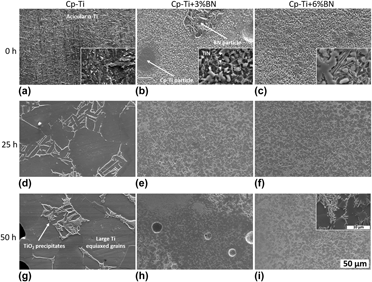Crossref Citations
This article has been cited by the following publications. This list is generated based on data provided by
Crossref.
Sharma, Priyanka
Khandelwal, Ayushi
and
Banerjee, M. K.
2019.
Structural evolution in a synthetically produced ultrafine grained low carbon steel.
SN Applied Sciences,
Vol. 1,
Issue. 11,
Otte, Joseph A.
Zou, Jin
Huang, Yang
and
Dargusch, Matthew S.
2020.
Ultrahigh Aspect Ratio TiB Nanowhisker-Reinforced Titanium Matrix Composites as Lightweight and Low-Cost Replacements for Superalloys.
ACS Applied Nano Materials,
Vol. 3,
Issue. 8,
p.
8208.
Rajabi, A.
Mashreghi, A.R.
and
Hasani, S.
2020.
Non-isothermal kinetic analysis of high temperature oxidation of Ti–6Al–4V alloy.
Journal of Alloys and Compounds,
Vol. 815,
Issue. ,
p.
151948.
Bustillos, Jenniffer
Lu, Xialong
Nautiyal, Pranjal
Zhang, Cheng
Boesl, Benjamin
and
Agarwal, Arvind
2020.
Boron Nitride Nanotube–Reinforced Titanium Composite with Controlled Interfacial Reactions by Spark Plasma Sintering.
Advanced Engineering Materials,
Vol. 22,
Issue. 12,
Gu, Dongdong
Shi, Xinyu
Poprawe, Reinhart
Bourell, David L.
Setchi, Rossitza
and
Zhu, Jihong
2021.
Material-structure-performance integrated laser-metal additive manufacturing.
Science,
Vol. 372,
Issue. 6545,
Monisha, K.
Shariff, S.M.
Manonmani, J.
and
Senthilselvan, J.
2021.
High power diode laser alloying of TiB2 and amorphous-boron with titanium: Phase, microstructure and hardness analyses.
Optik,
Vol. 239,
Issue. ,
p.
166758.
Svetlizky, David
Zheng, Baolong
Vyatskikh, Alexandra
Das, Mitun
Bose, Susmita
Bandyopadhyay, Amit
Schoenung, Julie M.
Lavernia, Enrique J.
and
Eliaz, Noam
2022.
Laser-based directed energy deposition (DED-LB) of advanced materials.
Materials Science and Engineering: A,
Vol. 840,
Issue. ,
p.
142967.
Yakubov, Vladislav
Kruzic, Jamie J.
and
Li, Xiaopeng
2022.
Heat‐Resistant Intermetallic Compounds and Ceramic Dispersion Alloys for Additive Manufacturing: A Review.
Advanced Engineering Materials,
Vol. 24,
Issue. 7,
Shtansky, Dmitry V.
Matveev, Andrei T.
Permyakova, Elizaveta S.
Leybo, Denis V.
Konopatsky, Anton S.
and
Sorokin, Pavel B.
2022.
Recent Progress in Fabrication and Application of BN Nanostructures and BN-Based Nanohybrids.
Nanomaterials,
Vol. 12,
Issue. 16,
p.
2810.
Bandyopadhyay, Amit
Traxel, Kellen D.
Lang, Melanie
Juhasz, Michael
Eliaz, Noam
and
Bose, Susmita
2022.
Alloy design via additive manufacturing: Advantages, challenges, applications and perspectives.
Materials Today,
Vol. 52,
Issue. ,
p.
207.
Abe, John O.
Popoola, Olawale M.
and
Popoola, Abimbola P. I.
2023.
Assessment of Nanomechanical and Tribological Performance of Refractory Nitride-Reinforced Titanium Alloy Matrix Composites Developed by Spark Plasma Sintering.
JOM,
Vol. 75,
Issue. 3,
p.
791.
Kaplan Akarsu, Melis
and
Akin, Ipek
2023.
Production and characterization of spark plasma sintered (Ti,Nb)B2 solid solutions with graphene nanoplatelets and hexagonal boron nitride.
Ceramics International,
Vol. 49,
Issue. 4,
p.
5582.
Sola, A.
and
Trinchi, A.
2023.
Boron-induced microstructural manipulation of titanium and titanium alloys in additive manufacturing.
Virtual and Physical Prototyping,
Vol. 18,
Issue. 1,
Gu, Dongdong
2023.
Laser Additive Manufacturing of Metallic Materials and Components.
p.
1.
Monisha, K.
Shariff, S.M.
Sekar, A.
Raju, Ravi
Manonmani, J.
and
Senthilselvan, J.
2024.
Titanium boride coating by high power diode laser alloying of amorphous boron with titanium and its surface property investigations.
Optics & Laser Technology,
Vol. 170,
Issue. ,
p.
110159.
Davis, Cole R.
Nuwayhid, R. Blake
Campbell, Caroline A.
Mills, Sara C.
Backman, Lavina
Estevez, Joseph E.
and
Schaeffer, Manda R.
2024.
Improved oxidation resistance of boron nitride nanotubes with protective alumina nano-coatings.
Ceramics International,
Vol. 50,
Issue. 22,
p.
48620.
Han, Niudong
Duan, Yadi
Zhang, Zhuhui
Yang, Yingxue
and
Zhang, Diantang
2024.
Fracture toughness and progressive damage mechanisms of 2.5D woven SiCf/SiC composites.
Journal of Reinforced Plastics and Composites,
Vol. 43,
Issue. 7-8,
p.
398.
Sun, Jingjia
Gu, Dongdong
Huang, Guangjing
Shi, Keyu
Wang, Rui
Wang, Ruiqi
Zhang, Yuxi
and
Wang, Liang
2024.
Effects of hexagonal boron nitride content on forming quality and performance of laser powder bed fusion manufactured nickel-based hastelloy X composites.
Composites Part B: Engineering,
Vol. 272,
Issue. ,
p.
111218.
Sola, A.
Jacob, J.
Kada, S.R.
Wang, J.
Lynch, P.A.
Brodie, E.
Trinchi, A.
and
Turney, T.W.
2024.
Grain refining in additively manufactured titanium using boron nitride nanosheets.
Journal of Materials Research and Technology,
Vol. 32,
Issue. ,
p.
3070.
Liu, Hanwen
Yan, Ming
Jing, Wang
Zeng, Guangming
XIE, Gengxin
Pu, Xiaojuan
Fu, Yukui
Peng, Xiangyu
Wang, Hou
Lai, Cui
Huang, Danlian
and
Tang, Lin
2024.
Hexagonal boron nitride for extreme environment application.
Diamond and Related Materials,
Vol. 148,
Issue. ,
p.
111410.



